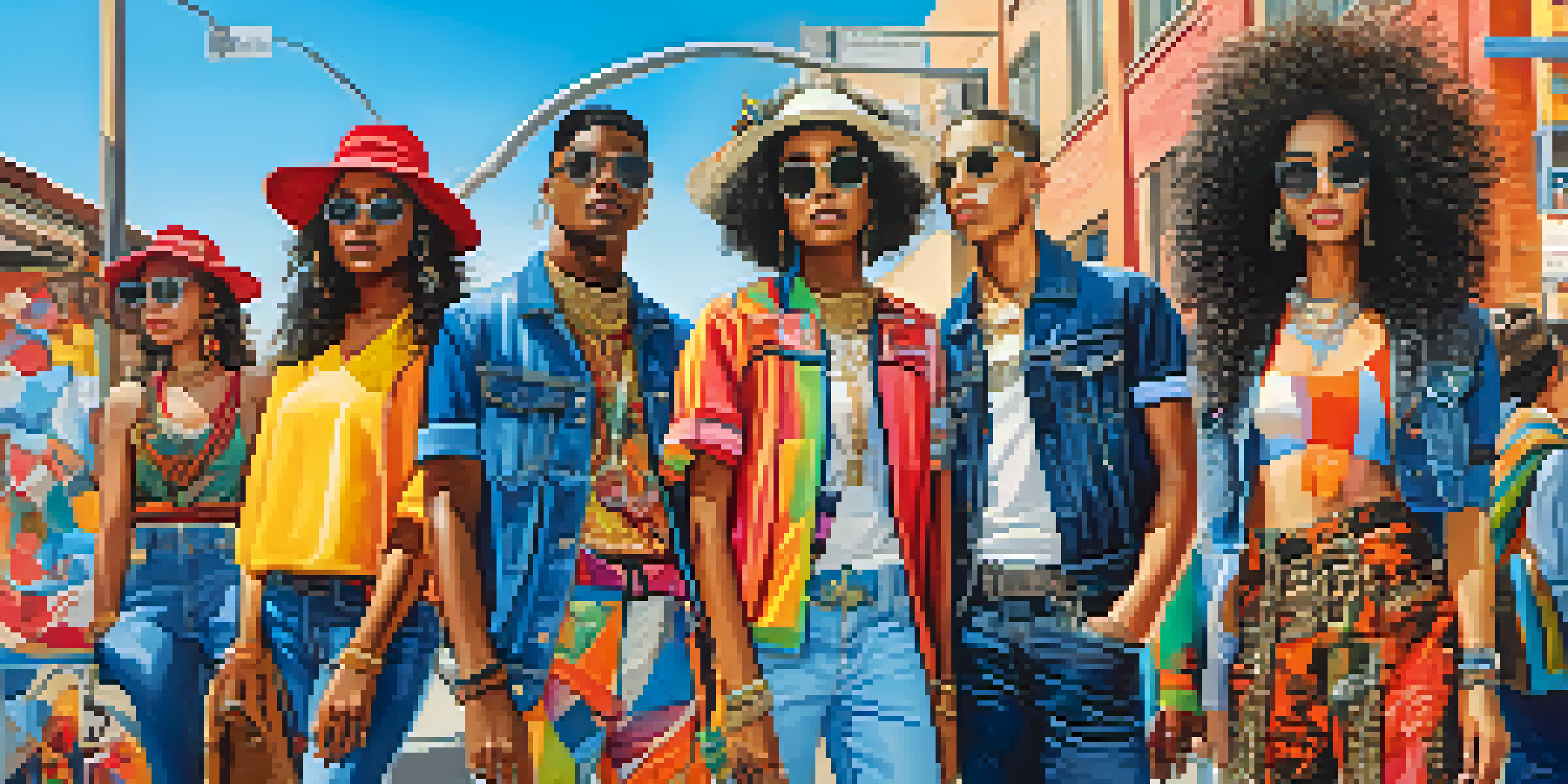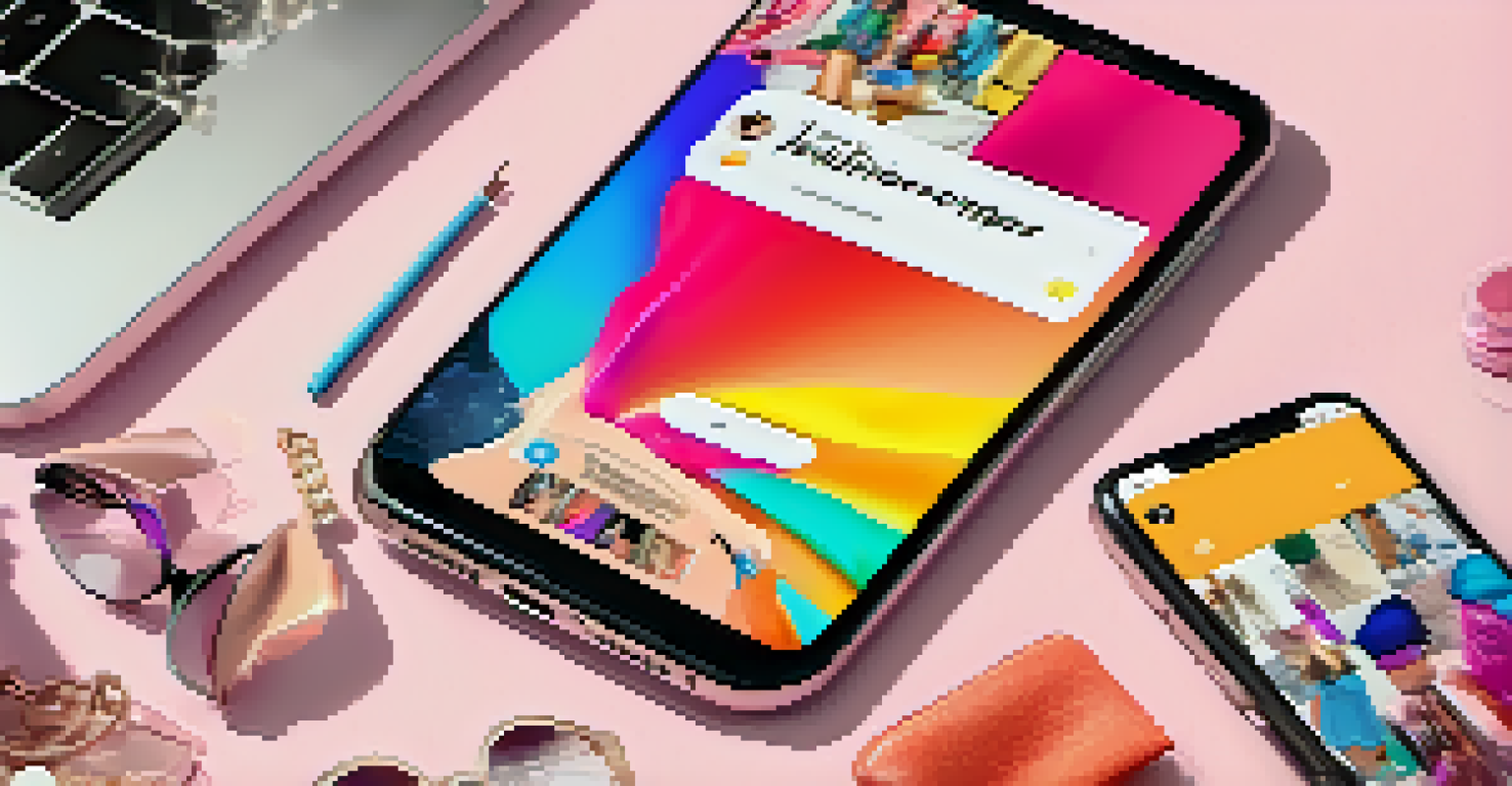Impact of Social Media on Fashion Trends and Market Dynamics

Social Media as a Trendsetter in Fashion
Social media platforms like Instagram and TikTok have revolutionized how fashion trends emerge. With influencers and brands sharing visually appealing content, styles can go viral overnight. This rapid dissemination of ideas allows trends to evolve quickly, keeping consumers on their toes and brands in a constant state of innovation.
Fashion is the armor to survive the reality of everyday life.
For instance, a simple hashtag challenge can spark a massive shift in what’s considered trendy, showcasing the power of user-generated content. This democratization of fashion allows smaller brands to gain visibility, often competing successfully with established names. As a result, the fashion industry sees an influx of fresh ideas and diversity.
Moreover, social media enables real-time feedback from consumers, allowing brands to gauge reactions to new collections almost instantly. This immediate communication not only nurtures a closer relationship between brands and consumers but also provides valuable insights into what styles resonate most.
Influencer Culture and Its Role in Fashion
Influencers have become pivotal in shaping consumer opinions and behaviors in the fashion world. With their large followings, they can sway trends simply by wearing a particular garment or accessory. Their authenticity, perceived or real, allows them to connect deeply with their audience, making their recommendations highly influential.

For example, when a celebrity or influencer showcases a specific brand, it can lead to a surge in sales and a newfound popularity for that brand. This phenomenon is often referred to as the 'influencer effect,' where a single post can lead to a significant spike in demand. Brands are increasingly collaborating with influencers to tap into this dynamic.
Social Media Drives Fashion Trends
Platforms like Instagram and TikTok allow trends to emerge rapidly, enabling smaller brands to compete with established names.
However, this relationship is a double-edged sword. If an influencer’s style doesn’t align with their audience, it can backfire, leading to negative perceptions of both the influencer and the brand. Thus, the alignment between influencer and brand becomes crucial for successful collaborations.
User-Generated Content and Its Fashion Impact
User-generated content (UGC) has emerged as a powerful force in the fashion industry. When consumers share their outfits or styling tips online, it fosters a sense of community and inspires others. This organic promotion often feels more genuine than traditional advertising, leading to higher engagement and brand loyalty.
In today's world, everyone's a fashion influencer.
Platforms like Instagram make it easy for consumers to showcase their personal style, often using specific brand tags or hashtags. This not only helps the brands gain visibility but also allows for a diverse representation of fashion that might not be covered in mainstream media. It’s a beautiful cycle where consumers become co-creators of trends.
Furthermore, brands that actively engage with UGC often see a boost in their reputation. When a brand acknowledges and shares its customers’ content, it creates a sense of belonging and appreciation. This interaction can transform casual consumers into brand advocates who passionately share their love for the brand.
The Speed of Trend Cycles in the Digital Age
The digital landscape has accelerated the speed at which fashion trends emerge and fade. In the past, a trend could last a season or more; now, trends can peak and wane within weeks. This fast-paced environment puts pressure on brands to continually innovate and respond to consumer desires.
For instance, the rise of 'micro-trends'—short-lived styles that capture the public's imagination—has become commonplace. These trends can be sparked by a viral video or a popular meme, leading to a frenzy of interest that often lasts just a few weeks. Brands must be agile, adapting quickly to these changes to stay relevant.
Influencers Shape Consumer Choices
Influencers have the power to sway trends and sales, but alignment with their audience is crucial for success.
Moreover, this rapid turnover can lead to consumer fatigue, where shoppers feel overwhelmed by the constant influx of new styles. As a result, brands need to find a balance between staying trendy and offering timeless pieces that withstand the test of time.
Sustainability and Social Media’s Influence
As consumers become more conscious of sustainability, social media plays a crucial role in promoting eco-friendly fashion. Many brands use their platforms to educate followers about sustainable practices, from ethical sourcing to the benefits of slow fashion. This awareness is helping to shift consumer behavior toward more responsible choices.
For example, campaigns that highlight the environmental impact of fast fashion have gained significant traction. Hashtags like #SustainableFashion encourage users to share their sustainable choices, influencing others to consider the environmental implications of their purchases. Social media thus becomes a vehicle for change, driving the movement toward conscious consumerism.
However, the challenge remains for brands to transparently communicate their sustainability efforts. Consumers are increasingly savvy and can easily spot greenwashing—when a brand exaggerates its eco-friendly claims. Authenticity and transparency are paramount in building trust with a socially conscious audience.
The Global Reach of Fashion Through Social Platforms
Social media has erased geographical boundaries in the fashion industry, allowing trends to spread globally at lightning speed. A style that emerges in one part of the world can quickly become a sensation in another, creating a truly interconnected fashion landscape. This global reach fosters a rich exchange of cultural influences.
For instance, street style from Tokyo may inspire designers in New York, leading to a fusion of ideas that enriches the global fashion narrative. Brands can now target diverse markets effectively, tailoring their messages to resonate with audiences across different cultures. This adaptability is vital in a world where consumers seek authenticity and relevance.
Sustainability Gains Ground Online
Social media promotes eco-friendly fashion and responsible consumerism, pushing brands to communicate their sustainability efforts transparently.
Additionally, this global interaction encourages inclusivity and representation, as various cultural elements find their way into mainstream fashion. Social media serves as a platform for voices from all walks of life, promoting diversity and challenging traditional beauty standards.
Future Trends: What Lies Ahead for Fashion and Social Media
As technology continues to evolve, the relationship between fashion and social media will likely deepen. Emerging technologies such as augmented reality (AR) and virtual reality (VR) are set to change how consumers interact with fashion. Imagine trying on clothes virtually before making a purchase—all from the comfort of your home.
Brands that embrace these technologies could significantly enhance the shopping experience, making it more personalized and engaging. Social media platforms are also likely to integrate more shopping features, allowing users to buy directly from posts. This seamless transition from browsing to purchasing could redefine consumer behavior.

Ultimately, the future will hinge on balancing innovation with sustainability. As fashion continues to evolve, brands must remain mindful of their environmental impact while embracing new tools and trends. The challenge will be to create a fashion landscape that is not only trendy but also responsible and inclusive.